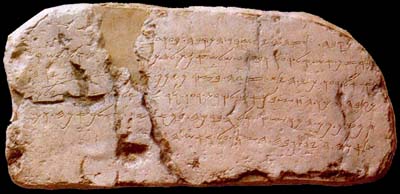It’s been busy around here, putting together the Future of Mormonism series. Other things too. But we’re back, trying to make up lost time. Here’s the podcast on lessons 29-30, which cover Elisha and then Hezekiah and Josiah.
[audio: http://media.patheos.com.s3.amazonaws.com/Media/MormonPodcastLesson2930.mp3]
Transcript
Download link for MP3 (right-click and “save as”
Notes:
Lesson 29- 2 Kings 2-6
Who are the “sons of the prophets”?
Is “the prophet” identical to “the President of the Church”? (It wasn’t before the 1950’s.)
Lesson 30- 2 Chronicles 29-34
These chapters cover about 130 years of history. Lots of sources inside the Bible (Kings, Chronicles, Isaiah, Nahum, Jeremiah, Habbukuk, and then later Ezekiel), and outside the Bible, both archaeological and textual (among others, the Babylonian Chronicles, Prism of Sennacherib, and Siloam Inscription. The latter two are discussed below.)
732– First Assyrian exile (or hauling off) of people in the northern kingdom of Israel. Isaiah is prophesying.
720-Sargon, King of Assyria, captures Samari after a 3-yr siege. End of the northern kingdom, and beginning of the Samaritans.
Assyrian policy towards conquered kingdoms–
Assyrian policy was geared towards maintaining its power, and it accomplished this goal by mixing up and resettling the peoples it conquered, who came from different places, had different religions, and spoke different languages. Being somewhere foreign and surrounded by people from different cultures and languages made it difficult to put together a coherent military rebellion. So, once captured, the 10 tribes of the northern kingdom are hauled off to Assyria, split up, mixed in with other captured peoples, and resettled all over the Assyrian empire. These are the famous so-called 10 lost tribes of Israel. Other mixed people are brought by the Assyrians to the land of the northern kingdom, and resettled among the lower class Israelites who remained there. They intermarry, and this is the beginning of the group known in the New Testament as the Samaritans. Because of this mixing of peoples and religions, Jews in the that area came to be regarded as impure, both doctrinally, genealogically, and in terms of ritual purity as well.
715– Hezekiah becomes king of Judah in the south.
Hezekiah’s illness- Chronicles, 2 Kings 20, and Isaiah 38.
704– Though an Assyrian vassal, Hezekiah refuses to pay tribute (2 Kings 18:7). (Judah had become an ASsyrian vassal under Hezekiah’s father, Ahaz. 2 Kings 16:7ff, “Ahaz sent messengers to King Tiglath-pileser of Assyria, saying, “I am your servant and your son. “)
As king, Hezekiah has a 1700ft tunnel dug connecting the Siloam pool with the Gihon spring in order to bring water into the city during a siege. This is known as Hezekiah’s tunnel. 2 Chronicles 32:1-4
For pictures and a map, see here and here. Video here from “Pastor Andy.” Walk-thru here from William Hamblin, BYU History professor
The Siloam Inscription, found inside the tunnel, explaining how it was made.

Aram = Aram-Naharaim “Aram of the Two-Rivers”= modern Syria.
701 Sennacherib, having put down several rebellions elsewhere, attacks the southern kingdom. He captures everything but Jerusalem, which is sieged. Eventually, Sennacherib draws off without capturing Jerusalem. Why exactly this is so isn’t known, but the Bible chalks it up to the angel of the Lord smiting 185,00 Assyrian soldiers overnight.
Sennacherib’s Account of his Military Campaign
One copy of the Prism of Sennacherib- (Translation from The Context of Scripture)-
(Translation from The Context of Scripture)-
“As for Hezekiah, the Judean, I besieged forty-six of his fortified walled cities and surrounding smaller towns, which were without number. Using packed-down ramps and applying battering rams, infantry attacks by mines, breeches, and siege machines, I conquered (them). I took out 200,150 people, young and old, male and female, horses, mules, donkeys, camels, cattle, and sheep, without number, and counted them as spoil. He himself, I locked up within Jerusalem, his royal city, like a bird in a cage. I surrounded him with earthworks, and made it unthinkable for him to exit by the city gate.
He, Hezekiah, was overwhelmed by the awesome splendor of my lordship, and he sent me after my departure to Nineveh, my royal city, his elite troops (and) his best soldiers, which he had brought in as reinforcements to strengthen Jerusalem, with 30 talents of gold, 800 talents of silver, choice antimony, large blocks of carnelian, beds (inlaid) with ivory, armchairs (inlaid) with ivory, elephant hides, ivory, ebony-wood, boxwood, multicolored garments, garments of linen, wool (dyed) red-purple and blue-purple, vessels of copper, iron, bronze and tin, chariots, siege shields, lances, armor, daggers for the belt, bows and arrows, countless trappings and implements of war, together with his daughters, his palace women, his male and female singers. He (also) dispatched his messenger to deliver the tribute and to do obeisance.”
PODCAST CORRECTION– Due to a typo in my notes, I said Hezekiah died shortly after Sennacherib’s attack. I wrote that Hezekiah died in 697 (i.e. 4 years after Sennacherib), but it’s actually 687, 14 years after.
Jerusalem can’t fall!
This story and some other things lead to a belief that Jerusalem can’t be taken.
1 Nephi 2:13 “Neither did [Laman or Lemuel] believe that Jerusalem, that great city, could be destroyed according to the words of the prophets.”
Cf. Jeremiah 7 and 26 (to be discussed in a future podcast)
See “How Could Jerusalem, ‘That Great City’ Be Destroyed?” in Glimpses of Lehi’s Jerusalem. The whole book is worth reading and buying, as it talks about Near Eastern history and Jerusalem in the time leading up to Lehi.
Josiah deserves his own podcast at some point.











